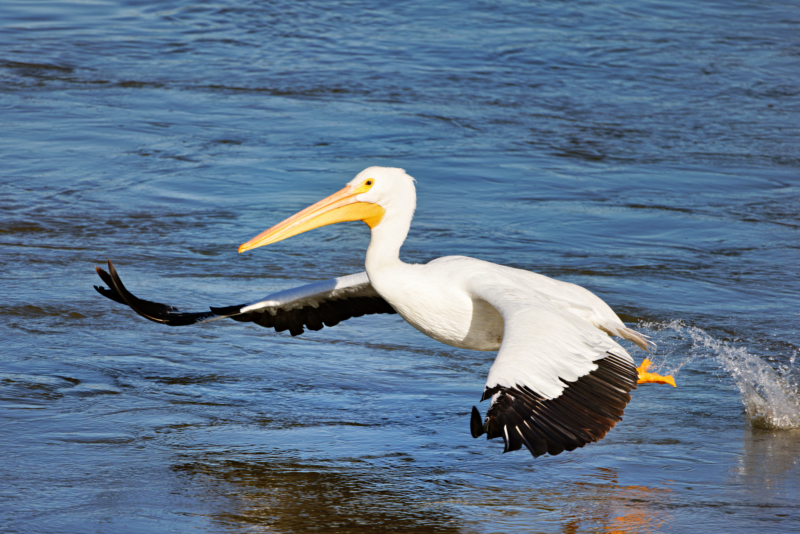Arkansas has seen strange weather patterns in fall 2024, shifting from drought to floods, with tornado warnings in November. While some may prefer milder days, I look forward to colder, more stable weather. When temperatures drop, I often head to Kerr Dam near Sallisaw, Oklahoma, to photograph the seasonal gathering of birds, including gulls, pelicans, and various waterfowl.

Why Birds Flock to Kerr Dam in Winter
Kerr Dam becomes a prime location for bird activity during winter due to specific ecological factors that draw diverse species.
- Open Water Access
The dam’s turbulent water prevents freezing, even in harsh conditions. This open water is critical for species that rely on aquatic habitats, like pelicans and gulls, which need clear access to fish. Bald Eagles and other raptors also benefit, as the open water attracts fish and other prey closer to the surface.
- Food Availability
Hydroelectric dams like Kerr create strong water currents that stir up fish, making them easy prey. Fish movement is influenced by turbine operations, which pull fish from deeper water levels. This makes Kerr Dam a rich hunting ground, particularly for species that feed on fish.
- Diverse Habitat
The areas around the dam often include mudflats, exposed beaches, and marsh-like zones created by fluctuating water levels. These diverse habitats attract shorebirds and migratory birds, adding variety to the species you can photograph.
- Social Behavior
Many birds flock in large numbers at high-food-density areas. Flocking provides protection against predators and increases their chances of successful feeding, making Kerr Dam a bustling scene during winter months.

Tips for Photographing Birds at Kerr Dam
Shooting in cold, damp conditions requires some preparation. Here’s how to make the most of your photography at Kerr Dam:
- Arrive Early
Birds are most active at dawn. Arriving early also allows you to capture softer light, which brings out more detail in the birds’ feathers and helps avoid harsh shadows.
- Use a Telephoto Lens
For bird photography, a telephoto lens (300mm or longer) is ideal. It allows you to photograph birds at a distance without disturbing them. Kerr Dam’s vast, open environment can make it challenging to get close, so a longer lens is invaluable.
- Position Strategically
Set up near areas with visible fish activity. Look for places where water currents meet or where birds are congregating to feed. Rocks along the shoreline often provide stable footing and a good vantage point but can be ice-cold, so bring an insulated mat if you plan to sit for long periods.
- Watch for Action Shots
Observe pelicans and gulls as they take off or dive. These behaviors offer dynamic shots. Pelicans, for instance, spread their wings wide during takeoff, and gulls often bank sharply when diving, showing off intricate feather patterns.
- Protect Your Gear
Cold weather can drain battery life quickly, so bring spares. Use a waterproof cover for your camera to protect against unexpected splashes or drizzle. Keeping your gear safe and dry is crucial for longer shoots.
- Capture Behavioral Interactions
Document interactions among birds, such as feeding or fighting over fish. These moments add storytelling elements to your images and showcase natural behaviors you might miss in milder seasons.
- Mind the Light Changes
Winter light can change fast, especially near water. Use a polarizing filter to reduce glare on bright days and maintain a faster shutter speed to avoid motion blur with moving birds.
Best Bird Species to Watch for at Kerr Dam
- American White Pelican
Known for its graceful flight and bright bill, the American White Pelican is a highlight here. Watch for their synchronized group movements and takeoff sequences, which make for striking photos.
- Gulls
Several types of Gulls are common at Kerr Dam in winter. They’re often seen hovering above the water or swooping down to snatch fish, offering plenty of action for photographers.
- Bald Eagles
With open water attracting fish, Bald Eagles are regular winter visitors. Capture them mid-dive or perched on nearby trees for an iconic shot.
- Double-crested Cormorants
These skilled divers are frequently seen at Kerr Dam, where they hunt for fish in the open water. Look for them perched with wings spread wide, drying off after a dive—an opportunity for unique shots that capture their distinctive silhouette.
Kerr Dam offers unique bird photography opportunities in winter. The cold weather draws in diverse species, and the open water keeps them close to shore. Dress warm, bring the right gear, and be prepared for a memorable experience photographing winter birds at Kerr Dam.
